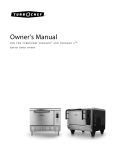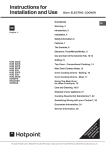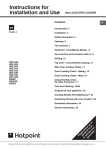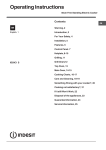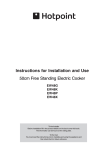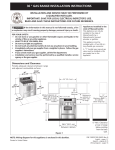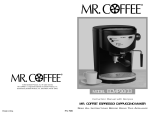Download Frigidaire 318200760 Range User Manual
Transcript
Gas Range Welcome .................................. 2 Important Safety Instructions .. 3-5 Features at a Glance ............. 6 Setting Surface Controls.... 7-8 Surface Cooking .................... 9 Before Setting Oven Controls ...................... 10 Setting Oven Controls ......... 10 Cooking Informations ..... 11-12 Adjusting Your Oven Temperature ................ 12 Care & Cleaning .............. 13-18 Before You Call Solutions to Common Problems ........................................... 18-19 Warranty ................ Back Cover 318200760 (0609) Rev. B Welcome & Congratulations Questions? 1-800-944-9044 (United States) 1-866-294-9911 (Canada) Please attach sales receipt here for future reference. Congratulations on your purchase of a new appliance! At Electrolux Home Products, we are very proud of our product and are completely committed to providing you with the best service possible. Your satisfaction is our number one priority. We know you’ll enjoy your new appliance and Thank You for choosing our product. We hope you consider us for future purchases. PLEASE CAREFULLY READ AND SAVE THESE INSTRUCTIONS This Use & Care Manual contains general operating instructions for your appliance and feature information for several models. Your product may not have all the described features. The graphics shown are representative. The graphics on your appliance may not look exactly like those shown. These instructions are not meant to cover every possible condition and situation that may occur. Common sense and caution must be practiced when installing, operating and maintaining any appliance. Please record your model and serial numbers below for future reference. Model Number: Serial Number: Purchase Date: Product Registration Register Your Product The PRODUCT REGISTRATION CARD should be filled in completely, signed and returned to Electrolux Home Products. Serial Plate Location Versión en español Si desea obtener una copia en español de este Manual del Usuario, sírvase escribir a la dirección que se incluye a continuación. Solicite la P/N 318200760E. Spanish Use & Care Manual Electrolux Home Products P. O. Box 212378 Augusta, GA 30917 © 2006 Electrolux Canada Corp. All rights reserved Printed in United States 2 Important Safety Instructions This manual contains many important safety messages. Always read and obey all safety messages. calls your attention to safety messages that inform you of hazards that can kill or hurt you or The safety symbol others, or cause damage to the product. Indicates an imminently hazardous situation which, if not avoided may result in death or serious injury. If the information in this manual is not followed exactly, a fire or explosion may result causing property damage, personal injury or death. FOR YOUR SAFETY: — Do not store or use gasoline or other flammable vapors and liquids in the vicinity of this or any other appliance. — WHAT TO DO IF YOU SMELL GAS: • Do not try to light any appliance. • Do not touch any electrical switch; do not use any phone in your building. • Immediately call your gas supplier from a neighbor's phone. Follow the gas supplier's instructions. • If you cannot reach your gas supplier, call the fire department. — Installation and service must be performed by a qualified installer, servicer or the gas supplier. 3 • • • • All ranges can tip. Injury to persons could result. Install anti-tip device packed with range. See Installation Instructions. To reduce the risk of tipping, the range must be secured by properly installed anti-tip bracket(s) provided with the range. To check if the bracket(s) is installed properly, remove the lower panel or storage drawer and verify that the anti-tip bracket(s) is engaged. Refer to the Installation Instructions for proper anti-tip bracket(s) installation. Important Safety Instructions • Wear proper apparel—Loose-fitting or hanging garments should never be worn while using the appliance. Do not let clothing or other flammable materials contact hot surfaces. • Do not use water or flour on grease fires—Smother the fire with a pan lid, or use baking soda, a dry chemical or foam-type extinguisher. • When heating fat or grease, watch it closely. Fat or grease may catch fire if allowed to become too hot. • • In case of fire or gas leak, be sure to turn off the main gas shutoff valve. • Use only dry potholders—Moist or damp potholders on hot surfaces may result in burns from steam. Do not let potholders touch hot heating elements. Do not use a towel or other bulky cloth instead of a potholder. • Do not heat unopened food containers—Buildup of pressure may cause container to burst and result in injury. • Remove the oven door from any unused range if it is to be stored or discarded. IMPORTANT—Do not attempt to operate the oven during a power failure. If the power fails, always turn the oven off. If the oven is not turns off and the power resumes, the oven may begin to operate again. Food left unattended could catch fire or spoil. • • • Use proper flame size—Adjust flame size so it does not extend beyond the edge of the utensil. The use of undersize utensils will exposed a portion of the burner flame to direct contact and may result in ignition of clothing. Proper relationship of utensil to flame will also improve efficiency. ignition of clothing. Proper relationship of utensil to the surface burner will also improve efficiency. Utensil handles should be turned inward and not extend over adjacent surface burners—To reduce the risk of burns, ignition of flammable materials, and spillage due to unintentional contact with the utensil. The handle of the utensil should be positioned so that it is turned inward, and does not extend over adjacent surface burners. Never leave surface burners unattended at high heat settings—Boilovers cause smoking and greasy spillovers that may ignite, or a pan that has boiled dry may melt. Protective liners—Do not use aluminum foil to line oven bottom or any other part of the appliance. Only use aluminum foil as recommended for baking if used as a cover placed on the food. Any other use of protective liners or aluminum foil may result in a risk of electric shock or fire or short circuit. Glazed cooking utensils—Only certain types of glass, glass/ceramic, ceramic, earthenware, or other glazed utensils are suitable for rangetop service without breaking due to the sudden change in temperature. Check the manufacturer’s recommendations for rangetop use. Do not use decorative surface burner covers. If a burner is accidentally turned on, the decorative cover will become hot and possibly melt. Burns will occur if the hot covers are touched. Damage may also be done to the cooktop or burners because the covers may cause overheating. Air will be blocked from the burner and cause combustion problems. FOR GLASS COOKTOPS ONLY • Do not clean or operate a broken cooktop—If cooktop should break, cleaning solutions and spillovers may penetrate the broken cooktop and create a risk of electric shock. Contact a qualified technician immediately. • Clean cooktop glass with caution—If a wet sponge or cloth is used to wipe spills on a hot cooking area, be careful to avoid a steam burn. Some cleaners can produce harmful fumes if applied to a hot surface. • Avoid scratching the cooktop glass with sharp objects. Do not use stove top grills on the burner grates of sealed gas burners. If you use a stove top grill on a sealed gas burner, it will cause incomplete combustion and can result in exposure to carbon monoxide levels above allowable current standards. This can be hazardous to your health. Electronic controllers can be damaged by cold temperatures. When you use your appliance for the first time, or if it has not been used for a long period of time, make sure that it has been exposed to a temperature above 0°C/32°F for at least 3 hours before connecting it to the power supply. IMPORTANT INSTRUCTIONS FOR USING YOUR OVEN • Use care when opening oven door or warmer drawer (if equipped)—Stand to the side of the range when opening the door of a hot oven. Let hot air or steam escape before you remove or replace food in the oven/ warmer drawer. • Keep oven vent ducts unobstructed. The oven vent is located at the rear of the cooktop. Touching the surfaces in this area when the oven is operating may cause severe burns. Also, do not place plastic or heat-sensitive items on or near the oven vent. These items could melt or ignite. IMPORTANT INSTRUCTIONS FOR USING YOUR COOKTOP • Know which knob controls each surface heating unit. Always turn the knob to the LITE position when igniting the burners. Visually check that burner has lit. Then adjust the flame so it does not extend beyond the edge of the utensil. • Use proper pan size. This appliance is equipped with one or more surface burners of different sizes. Select utensils having flat bottoms large enough to cover the surface burner. The use of undersized utensils will expose a portion of the surface burner to direct contact and may result in 4 NEVER cover any slots, holes or passages in the oven bottom or cover an entire rack with materials such as aluminum foil. Doing so blocks air flow through the oven and may cause carbon monoxide poisoning. Aluminum foil linings may trap heat, causing a fire hazard. Important Safety Instructions • Placement of oven/warmer drawer (if equipped) racks. Always place oven racks in desired location while oven/ warmer drawer (if equipped) is cool. If rack must be moved while oven is hot use extreme caution. Use potholders and grasp the rack with both hands to reposition. Do not let potholders contact the hot heating elements in the oven/warmer drawer (if equipped). Remove all utensils from the rack before moving. • Do not use the broiler pan without its insert. The broiler pan and its insert allow dripping fat to drain and be kept away from the high heat of the broiler. • Do not cover the broiler insert with aluminum foil. Exposed fat and grease could ignite. • Do not touch a hot light bulb with a damp cloth. Doing so could cause the bulb to break. Disconnect the appliance or turn off the power to the appliance before removing and replacing light bulb. SELF CLEANING OVENS • In the self-Cleaning cycle only clean the parts listed in this Use and Care Guide. Before self cleaning the oven, remove the broiler pan and any utensils or foods from the oven. • Do not use oven cleaners—No commercial oven cleaner or oven liner protective coating of any kind should be used in or around any part of the oven. • Do not clean door gasket—The door gasket is essential for a good seal. Care should be taken not to rub, damage or move the gasket. • Remove oven racks. Oven racks color will change if left in the oven during a self-cleaning cycle. The health of some birds is extremely sensitive to the fumes given off during the self-cleaning cycle of the range. Move the birds to another well ventilated room. Important Safety Notice IMPORTANT INSTRUCTIONS FOR CLEANING The California Safe Drinking Water and Toxic Enforcement YOUR RANGE • Clean the range regularly to keep all parts free of grease that could catch fire. Exhaust fan ventilation hoods and grease filters should be kept clean. Do not allow grease to accumulate on hood or filter. Greasy deposits in the fan could catch fire. When you are flaming food under the hood, turn the fan on. Refer to the hood manufacturer’s instructions for cleaning. Act requires the Governor of California to publish a list of substances known to the state to cause cancer, birth defects or other reproductive harm, and requires businesses to warn customers of potential exposure to such substances. SAVE THESE INSTRUCTIONS Grounding Instructions For personal safety, the cooktop must be properly grounded. For maximum safety, the power cord must be plugged into an electrical outlet that is correctly polarized and properly grounded. DO NOT Operate the cooktop using a 2-prong adapter or an extension cord. If a 2-prong wall receptacle is the only available outlet, it is the personal responsibility of the consumer to have it replaced with a properly grounded 3-prong wall receptacle installed by a qualified electrician. See the INSTALLATION INSTRUCTIONS packaged with this range for complete installation and grounding instructions. This appliance is equipped with a 3-prong grounding plug for your protection against shock hazard and should be plugged directly into a properly grounded receptacle. DO NOT cut or remove the grounding prong from this plug. Personal injury or death from electrical shock may occur if the range is not installed by a qualified installer or electrician. Grounding type wall receptacle Do not, under any circumstances, cut, remove, or bypass the grounding prong. Power supply cord with 3-prong grounding plug Avoid fire hazard or electrical shock. DO NOT use an adapter plug, an extension cord, or remove grounding prong from electrical power cord. Failure to follow this warning can cause serious injury, fire or death. Conversion to Liquefied Petroleum Gas (or L. P. Gas) This natural gas range is designed to allow for conversion to Liquefied Petroleum (L. P.) Gas. installation instructions which must be read before and followed carefully when installing the kit. Only a qualified service agent should perform the L. P. conversion. Call an authorized servicer if you wish to have them perform the conversion. An L. P. Conversion Kit is provided with this range and is located on the main back of the range. The kit contains To avoid serious injury, any additions, changes or conversions required in order for this appliance to satisfactorily meet the application needs must be made by a qualified service agent. 5 6 Setting Surface Controls Assembly of the Surface Burner Heads, Burner Caps and Burner Grates Locations of the Gas Surface Burners The SIMMER burner is best used for simmering delicate sauces, etc. This burner is located at the right rear burner position on the cooktop. The STANDARD sized burners are used for most surface cooking needs. These burners are located at the left rear and center positions on the cooktop. The POWER burners are best used for bringing large quantities of liquid rapidly up to temperature or when preparing larger quantities of food. These burners are located at the right front and left front positions on the cooktop. 7 8 Surface cooking 9 O VEN LIGHT C LOCK O VEN C OOK T IME KITCHEN T IMER DELAY S TART A DD 1 M INUTE O N/ O FF O VEN F LEX C LEAN O N/ O FF B AKE B ROIL S LOW COOK W ARM & H OLD S TOP R ECIPE R ECALL PREHEA T DOOR L OCKED C LEAR O VEN LOCKOUT 10 Cooking Informations Oven Baking For best cooking results, heat the oven before baking cookies, breads, cakes, pies or pastries, etc... There is no need to preheat the oven for roasting meat or baking casseroles. The cooking times and temperatures needed to bake a product may vary slightly from your previously owned appliance. Baking Problems and Solutions Chart Baking Problems Causes Corrections Cookies and biscuits burn on the bottom. • • Allow oven to preheat to the selected temperature before placing food in oven. • Cookies and biscuits put into the oven before the preheating time is completed. Oven rack overcrowded. • Dark pan absorbs heat too fast. • • • Cakes put into the oven before preheating time is completed. Rack position too high or low. Oven too hot. • Allow oven to preheat to the selected temperature before placing food in the oven. • Use proper rack position for baking needs. • Set oven temperature 25°F/12°C lower than recommended. Cakes not done in the center. • • • Oven too hot. Incorrect pan size. Pan not centered in oven. • Set oven temperature 25°F/12°C lower than recommended. • Use pan size suggested in recipe. • Use proper rack position and place pan so there is 5.1 cm to 10.2 cm (2” to 4”) of space on all sides of pan. Cakes not level. • Range not level. • • Pan too close to oven wall or rack overcrowded. Pan warped. • Place a marked glass measuring cup filled with water on the center of the oven rack. If the water level is uneven, refer to the installation instructions for leveling the range. • Be sure to allow 5.1 cm to 10.2 cm (2” to 4”) of clearance on all sides of each pan in the oven. • Do not use pans that are dented or warped. • Oven too cool. • Oven overcrowded. • Oven door opened too frequently. Cakes too dark on top or bottom. Foods not done when cooking time is up. • Choose pan sizes that will permit 5.1 cm to 10.2 cm (2” to 4”) of air space on all sides when placed in the oven. • Use a medium-weight aluminum baking sheet. • Set oven temperature 25°F/12°C higher than suggested and bake for the recommended time. • Be sure to remove all pans from the oven except the ones to be used for baking. • Open oven door only after shortest recommended baking time. 11 Cooking Informations Grid Broiling Broiling is a method of cooking tender cuts of meat by direct heat under the broil element of the oven. A beep lets you know when the broil temperature is reached. Be sure you center the broiler pan directly under the broil burner for best results. Arrange oven rack while oven is still cool. Position the rack as needed. The broiler pan and its insert allow dripping grease to drain and be kept away from the high heat of the broiler. DO NOT use the pan without its insert. DO NOT cover the insert with foil. The exposed grease could ignite. Should an oven fire occur, close the oven door and turn off the oven. If the fire continues, throw baking soda on the fire or use a fire extinguisher. DO NOT put water or flour on the fire. Flour may be explosive and water can cause a grease fire to spread and cause personal injury. To set for broiling: Refer to the Timer Guide Broiler Clean-Up Tips: To make cleaning easier, line the bottom of the broiler pan with aluminum foil. DO NOT cover the broiler grid with foil. To prevent grease from baking on, remove the broiler pan from the oven as soon as cooking is completed. Use hot pads because the broiler pan is extremely hot. Pour off grease. Soak the pan in HOT, soapy water. Clean the broiler pan as soon as possible after each use. If necessary, use soap-filled steel wool pads. Heavy scouring may scratch the grid. Broiler Pan Figure 1 Note: The broiler pan and the insert allows grease to drain and be kept away from the high heat of the broiler. DO NOT use the pan without the insert. DO NOT cover the insert with foil; the exposed grease could ignite. Adjusting Your Oven Temperature For instructions on how to adjust the oven temperature refer to the electronic oven control guide. 12 13 Care & Cleaning (Cleaning Chart) Cleaning Various Parts of Your Range Before cleaning any part of the range, be sure all controls are turned OFF and the range is cool. Remove spillovers and heavy soiling as soon as possible. Regular cleanings will reduce the effort required for major cleanings later. Surfaces How to Clean Aluminum & Vinyl Control Panel and Trim Pieces Use hot, soapy water and a cloth. Dry with a clean cloth. Glass, Painted and Plastic Body Parts, Control Knobs and Decorative Trim Pieces Using a soft cloth, clean with mild dish detergent and water or a 50/50 solution of vinegar and water. Follow by rinsing the area with clean water; dry and polish with a soft cloth. Glass cleaners may be used if sprayed on a soft cloth first. DO NOT spray liquids directly on the control pad and display area. Do not use large amounts of water on the control panel - excess water on the control area may cause damage to the appliance. Do not use other liquid cleaners, abrasive cleaners, scouring pads, or paper towels - they will damage the finish. To remove control knobs, turn to the OFF position; grasp firmly and pull straight off the shaft. To replace knobs after cleaning, line up the flat sides of both the knob and the shaft; then push the knob into place. Stainless Steel (some models) Oven door & drawer front panel Clean with hot, soapy water and dishcloth. Rinse with clean water and cloth. Do not use cleaners with high concentrations of chlorides or chlorines. Do not use harsh scrubbing cleaners. Only use kitchen cleaners that are especially made for cleaning stainless steel. Always be sure to rinse the cleaners off from the surface as bluish stains may occur during heating that cannot be removed. Oven Racks Remove racks. See "To remove and to replace an oven rack" under Oven vent(s) and racks. Use a mild, abrasive cleaner, following manufacturer's instructions. Rinse with clean water and dry. After cleaning the racks, rub the sides of the racks with wax paper or a cloth containing a small amount of baby oil or salad oil (this will make the racks glide easier into the rack positions). Porcelain Enamel Broiler Pan and Insert, Door Liner, Body Parts. Gentle scouring with a soapy scouring pad will remove most spots. Rinse with a 1:1 solution of clear water and ammonia. If necessary, cover difficult spots with an ammonia-soaked paper towel for 30 to 40 minutes. Rinse with clean water and a damp cloth, and then scrub with a soap-filled scouring pad. Rinse and wipe dry with a clean cloth. Remove all cleaners or the porcelain may become damaged during future heating. DO NOT use spray oven cleaners on the cooktop. Oven Door Use soap & water to thoroughly clean the top, sides and front of the oven door. Rinse well. You may use a glass cleaner on the outside glass of the oven door. DO NOT immerse the door in water. DO NOT spray or allow water or the glass cleaner to enter the door vents. DO NOT use oven cleaners, cleaning powders or any harsh abrasive cleaning materials on the outside of the oven door. DO HAND CLEAN FRAME DO NOT HAND CLEAN OVEN DOOR GASKET DO HAND CLEAN DOOR Cooktop, Burner Heads, Burner Caps & Grates Before cleaning the control panel, turn all controls to OFF and remove the control knobs. To remove, pull each knob straight off the shaft. Clean using hot, soapy water and a dishcloth. Rinse with a clean water and a dishcloth. Be sure to squeeze excess water from the cloth before wiping the panel; especially when wiping around the controls. Excess water in or around the controls may cause damage to the appliance. Be sure to rinse the cleaners as bluish stains may occur during heating and cannot de removed. To replace knobs after cleaning, line up the flat sides of both the knob and the shaft; then push the knob into place. DO NOT clean the oven door gasket. The oven door gasket is made of a woven material, on SelfCleaning models, which is essential for a good seal. Care should be taken not to rub, damage or remove this gasket. See Cleaning the Cooktop, Burner Caps, Burner Heads & Grates in the General Care & Cleaning section for complete instructions. 14 Care & Cleaning (Cleaning Chart) Cleaning the Cooktop, Burner Heads, Caps & Grates The cooktop is designed to make cleaning easier. Because the gas Burners are sealed, cleanups are easy when spillovers are cleaned up immediately. The cooktop, Burner Heads and Caps should be routinely cleaned. Keeping the Burner Head Ports clean will prevent improper ignition and an uneven flame. Refer to the following instructions: THE COOKTOP IS NOT REMOVABLE. Do not attempt to remove or lift the cooktop. THE FIXED OVEN VENT IS NOT REMOVABLE. Do not attempt to remove the fixed oven vent cover. Use caution when replacing the Burner Caps so the Electrodes are not damaged. This may cause a delayed ignition or prevent the burner from igniting. Surface Burner Grate To Remove and Replace the Surface Burner Caps and Burner Heads - Remove in the following order: (1st) surface Burner Grates, (2nd) Burner Caps and (3rd) Burner Heads. Replace in the following order: Burner Heads, Burner Caps and Burner Grates. 1st Do not remove any parts from the cooktop until they have completely cooled and are safe to handle. Do not operate the surface Burners without the Burner Caps and Burner Heads properly in place. Surface Burner 2nd Cap Surface 3rd Burner Head To Clean the surface Burner Caps and Burner Heads (all models)- Use a soap-filled scouring pad or a mild abrasive cleanser to clean the surface Burner Caps and Burner Heads. The ports (or slots) around the Burner Heads must be routinely cleaned. If residue still remains in these ports, use a small-gauge wire or needle to clean the slots or holes. For proper flow of gas and ignition of the burner—DO NOT ALLOW SPILLS, FOOD, CLEANING AGENTS OR ANY OTHER MATERIAL TO ENTER THE GAS ORIFICE HOLDER OPENING. ALWAYS keep the surface Burner Caps and Burner Heads in place whenever the gas Burners are in use. To Clean the Burner Grates- The Burner Grates are dishwasher safe and may be cleaned in the dishwasher. Remove any excessive soils before placing in the dishwasher. Electrode Orifice holder To Clean the Ceramic Glass Cooktop- See Ceramic Glass Cooktop Cleaning & Maintenance later in this section. Figure 1 Ceramic Glass Cooktop Cleaning and Maintenance Consistent and proper cleaning is essential to maintaining your ceramic glass cooktop Prior to using your cooktop for the first time, apply some of the cooktop cleaning cream supplied with your range. Buff with a non-abrasive cloth or pad (such as a 3M Scotch-Brite® Blue Multi-Purpose No Scratch Scrub Sponge). This will make cleaning easier when soiled from cooking. The special cooktop cleaning cream leaves a protective finish on the glass to help prevent scratches and abrasions. Sliding aluminum or copper clad bottom pans on the cooktop can cause metal markings on the cooktop surface. These marks should be removed immediately after the cooktop has cooled using the cooktop cleaning cream. Metal marks can become permanent if not removed prior to future use. Cookware (cast iron, metal, ceramic or glass) with rough bottoms can mark or scratch the cooktop surface. Do not slide anything metal or glass across the cooktop. Do not use your cooktop as a cutting board or work surface in the kitchen. Do not cook foods directly on the cooktop surface without a pan. Do not drop heavy or hard objects on the glass cooktop, they may cause it to crack. 15 Cleaning Recommendations for the Ceramic Glass Cooktop Before cleaning the cooktop, be sure the controls are turned to OFF and the cooktop is COOL. DO NOT use a cooktop cleaner on a hot cooktop. The fumes can be hazardous to your health, and can chemically damage the ceramic-glass surface. For light to moderate soil: Apply a few drops of CookTop® Cleaning Creme directly to the cooktop. Use a paper towel or a 3M Scotch-Brite® Blue Multi-Purpose No Scratch Scrub Sponge to clean the entire cooktop surface. Make sure the cooktop is cleaned thoroughly, leaving no residue. For heavy, burned on soil: Apply a few drops of CookTop® Cleaning Creme directly to the soiled area. Rub the soiled area using a 3M Scotch-Brite® Blue Multi-Purpose No Scratch Scrub Sponge, applying pressure as needed. Do not use the sponge you use to clean the cooktop for any other purpose. 16 Care & Cleaning To Remove and Replace Oven Door The door is heavy. For safe, temporary storage, lay the door flat with the inside of the door facing down. The oven door can be removed to make oven cleaning easier. To Remove Oven Door: 1. Open door approximately 4 inches to the stop position. 2. Grasp door at side edges. 3. Lift door up and off hinges. 4. To clean oven door, see the cleaning chart at beginning of this section. To Replace Oven Door: 1. Be sure the hinge arms are in the stop position. Be careful if pulling the hinges open by hand. The hinges may snap back against the oven frame and could pinch fingers. 2. Hold the door at the sides near the top. 3. Slide the door down onto the hinges as far as it will go and close the door. 4. If the door is not in line with the oven frame, remove door and repeat the above steps. Grasp the oven bottom by the front corner on each side to raise and lower the oven bottom. 17 Care & Cleaning Changing Oven Light Be sure the oven is unplugged and all parts are COOL before replacing the oven light bulb. Do not turn the oven light on during a self-cleaning cycle. High temperature will reduce lamp life. The interior oven light will turn on automatically when the oven is opened. The oven light may be turned on when the door is closed by using the oven light switch located on the Electronic Oven control. The oven light bulb is covered with a glass shield held in place by a wire holder. THIS GLASS SHIELD MUST ALWAYS BE IN PLACE WHEN THE OVEN IS IN USE. To Replace the Light Bulb: 1. 2. 3. 4. BE SURE OVEN IS COOL Turn the power off at the main source. Wear a leather-faced glove for protection against possible broken glass. Replace bulb with a 40 Watt appliance bulb only. Press wire holder to one side to release glass shield, change bulb and be sure to replace glass shield. Before you call Solutions to Common Problems OCCURRENCE POSSIBLE CAUSE/SOLUTION Range is not level. (1) Poor installation. Place oven rack in center of oven. Place a level on the oven rack. Adjust leveling legs at base of range until the rack is level. When range is level, cooktop may appear out of alignment if countertop is not level. (2) Weak, unstable floor. Be sure floor is level and can adequately support range. Contact a carpenter to correct sagging or sloping floor. (3) Kitchen cabinet misalignment may make range appear to be unlevel. Be sure cabinets are square and have sufficient room for range clearance. Cannot move appliance easily. Appliance must be accessible for service. (1) Cabinets not square or are built in too tight. Contact a cabinet maker to correct the problem. (2) Contact builder or installer to make appliance accessible. (3) Carpeting interferes with range. Provide sufficient space so range can be lifted over carpet. (4) Gas line is hard-plumbed. Have a flexible C.S.A international approved metal appliance connector installed. Entire range or oven does not operate. (1) Make sure cord/plug is tightly into outlet. (2) Service wiring is not complete. Call service (See warranty information). (3) Electrical power outage. Check house lights to be sure. Call your local electric company for service. Surface burners can be lit manually. Surface burners do not light. (1) Surface control knob has not been completely turned to LITE. Push in and turn the surface control knob to LITE until burner ignites and then turn the surface control knob to the desired flame size. (2) Burner ports are clogged. Clean burners. See “Cleaning the Burner Grates, Burner Caps and Burner Heads” under General Cleaning. (3) Range power is disconnected from outlet. Be sure cord is securely plugged into the outlet. (4) Electrical power outage. (5) Be sure the gas supply to the range is turned “ON”. Surface burner flame burns half way around. (1) Burner ports are clogged. With the burner off, clean ports by using a small-gauge wire or needle. (2) Moisture is present after cleaning. Lightly fan the flame and allow burner to operate until flame is full. Dry the burners thoroughly following instructions in the "General Care & Cleaning" section. Surface burner flame is orange. (1) Dust particles in main line. Allow the burner to operate a few minutes until flame turns blue. (2) Salt air in coastal areas. A slightly orange flame is unavoidable. Scratches or abrasions on cooktop surface. (1) Coarse particles such as salt or sand between cooktop and utensils can cause scratches. Be sure cooktop surface and bottoms of utensils are clean before usage. Small scratches do not affect cooking and will become less visible with time. (2) Cleaning materials not recommended for ceramic-glass cooktop have been used. See “Ceramic Glass Cooktop Cleaning & Maintenance” section under General Care & Cleaning. (3) Cookware with rough bottom has been used. Use smooth, flat-bottomed cookware. 18 Before you call Solutions to Common Problems Metalmarks. (1) Sliding or scraping of metal utensils on cooktop surface. Do not slide metal utensils on cooktop surface. Use a ceramic-glass cooktop cleaning cream to remove the marks. See “Ceramic Glass Cooktop Cleaning & Maintenance” section under General Care & Cleaning. Brown streaks or specks. (1) Boilovers are cooked onto surface. Use razor blade scraper to remove soil. See “Ceramic Glass Cooktop Cleaning & Maintenance” section under General Care & Cleaning. Areas of discoloration with metallic sheen. (1) Mineral deposits from water and food. Remove using a ceramic glass cooktop cleaning cream. Use cookware with clean, dry bottoms. *Oven control beeps and displays any F code error (for example F11) (1) Electronic control has detected a fault condition. Press STOP/CLEAR to clear the display and stop beeping. Reprogram oven. If fault recurs, record fault number. Press STOP/CLEAR and call an authorized servicer. Oven light does not work. (1) Replace bulb. See “Changing Oven Light” in this Use and Care Guide for instructions. Poor baking results. (1) Many factors affect baking results. Make sure the proper rack position is used. Center food in the oven and space pans to allow air to circulate. If conventional baking, allow the oven to preheat to the set temperature before placing food in the oven. Try adjusting the recipe’s recommended temperature or baking time. If you feel the oven is too hot or cool, see “Adjusting the Oven Temperature” section in this Use and Care Guide. Fan noise during cooking operation. (1) A cooling fan may automatically turn on and off to cool internal parts. It is normal, and the fan may continue to run after the range has been turned “OFF”, but may also stop immediately and then turn “ON” after a while. Flames inside oven or smoking from vent. (1) Excessive spillovers in oven. Set self-clean cycle for a longer cleaning time. (2) Excessive spillovers in oven. This is normal, especially for pie spillovers or large amounts of grease on the oven bottom. Wipe up excessive spillovers before starting the self-clean cycle. If flames or excessive smoke are present, stop the self-clean cycle and follow the steps under "Stopping or Interrupting a SelfCleaning Cycle" in this Use and Care Guide. Oven smokes excessively during broiling. (1) Meat is too close to the element. Reposition the rack to provide proper clearance between the meat and the oven broil element. (2) The insert on broiler pan wrong side up and grease not draining. Always place insert on the broiler pan with ribs up and slots down to allow grease to drip into pan. (3) Meat is not properly prepared. Remove excess fat from meat. Remove remaining fatty edges to prevent the meat from curling, but do not cut into the lean of the meat. (4) Broiler pan used without the Broiler Pan Insert or insert is covered with foil. DO NOT use the Broiler Pan without the Broiler Pan Insert or cover the insert with foil. (5) Broiler Pan or Broiler Pan Insert needs to be cleaned. Excessive smoking is caused by build-up of grease or food spatters. Clean the Broiler Pan and Insert on a regular basis. (6) Oven door is open. Oven door should be closed when broiling. Self-cleaning cycle does not (1) Control(s) not set properly. Follow instructions under “Self-Cleaning” in this Use and Care work. Guide. (2) Self-cleaning cycle was interrupted. Stop time must be 3 to 4 hours past the start time. Follow steps under "Stopping or Interrupting a Self-Cleaning Cycle" in this Use and Care Guide. (3) Set SelfClean cycle for a longer cleaning time. Soil not completely removed after self-cleaning cycle. (1) Hand clean bottom, front top of oven, frame or door area outside oven seal before the selfcleaning is started. These areas are not in the self-cleaning area, but get hot enough to burn on residue. Burned-on residue can be cleaned with a stiff nylon brush and water or nylon scrubber. Be careful not to damage the oven seal by attempting to clean it. Excessive smoking from oven vent. (1) Excessive spillovers in oven, especially for pie spillovers or large amounts of grease on the oven bottom. Wipe up excessive spillovers before starting the Self-Clean cycle. If flames or excessive smoke are present, stop the Self-Clean cycle and follow the steps under "Stopping or Interrupting the Self-Cleaning Cycle" in this Use and Care Guide. 19 Warranty Information 20





















